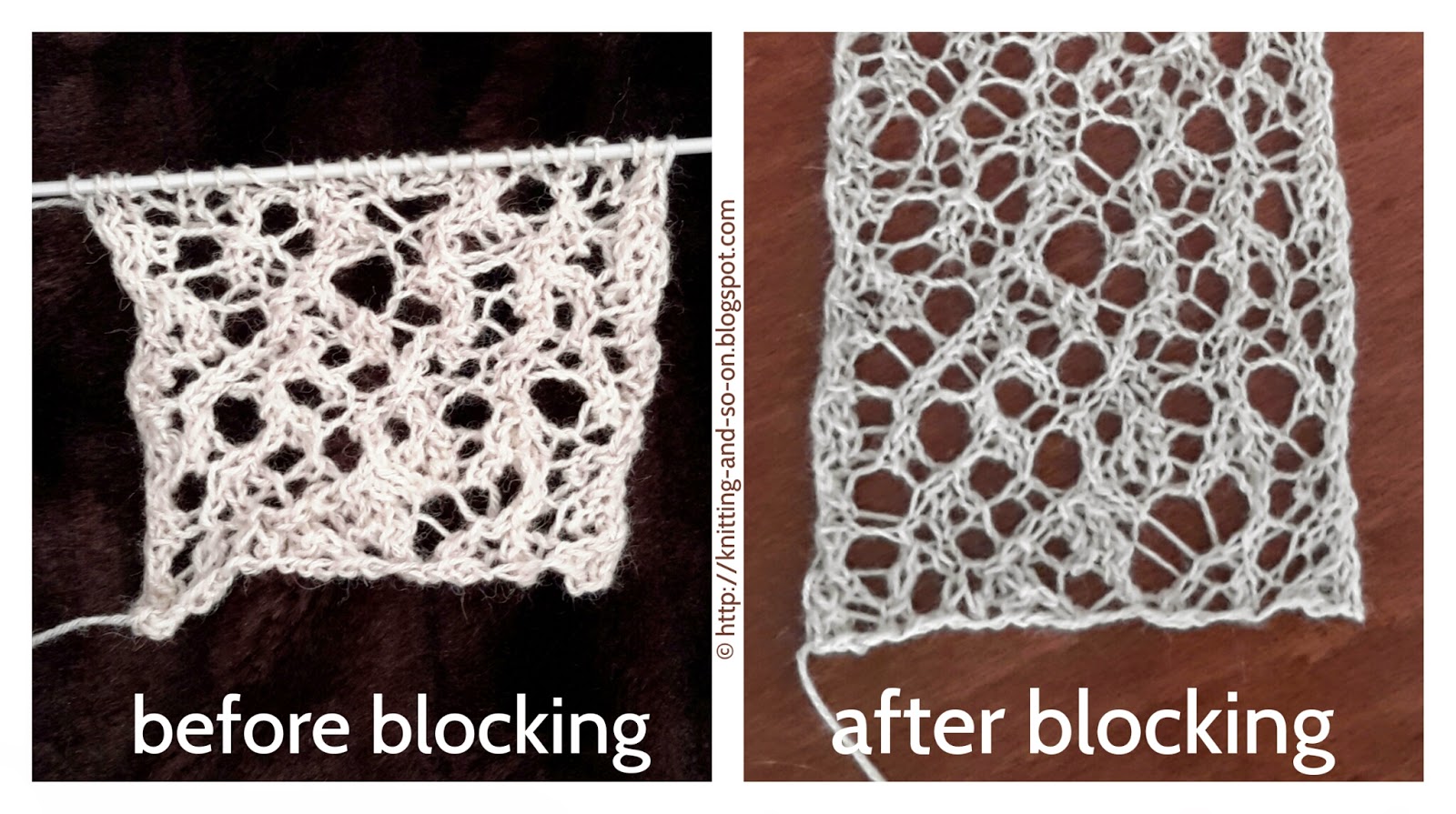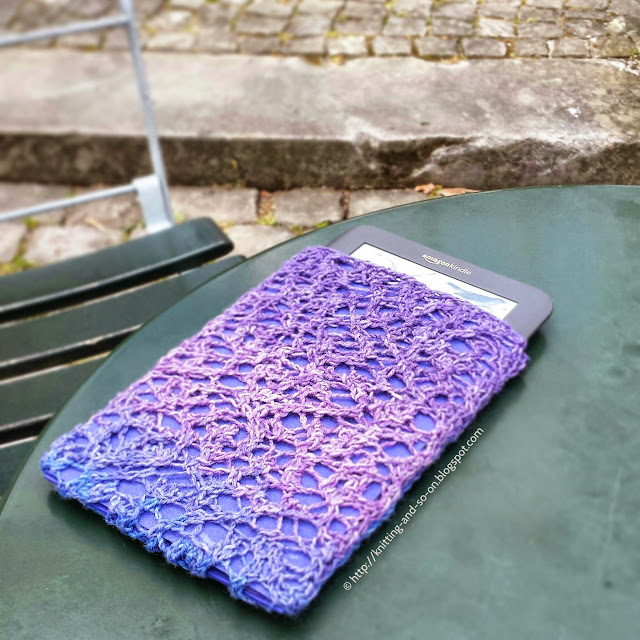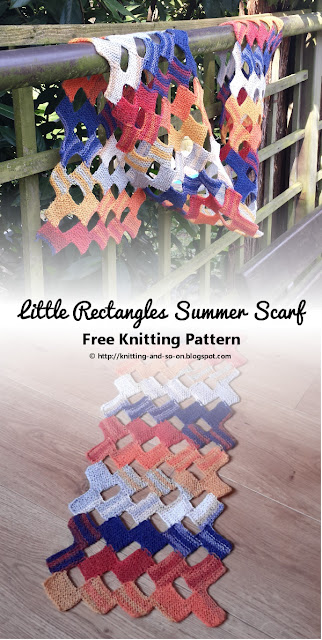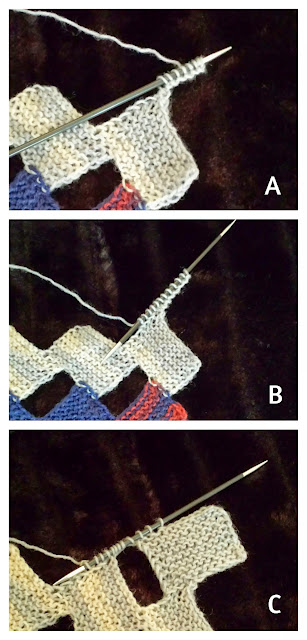This scarf is knitted (nearly) only in garter stitch; the graphic effect is achieved with short rows.


This work by Knitting and so on is licensed under a Creative Commons Attribution-NonCommercial-ShareAlike 4.0 International License.
There are two versions of instructions – one (short and descriptive) that just gives the gist of what is done when. And one with rows and stitches spelled out.
Personally, I prefer instructions given in the short style (or rather that’s the way I started thinking about the pattern), but I know that instructions like this can confusing for others and are uncommon. That’s why there is a normal version as well.
Please note, that the scarf is not quite symmetrical.
Material
- about 100 grams of fingering weight yarn in Color 1 (light green on the photos)
- about 100 grams of fingering weight yarn in a contrasting color (Color 2, purple on the photos)
(the yarn used for this project is Malabrigo Sock - Colors 037 Lettuce and 141 Dewberry.) - a circular knitting needle (3mm) or a long double pointed needle
- a tapestry needle to weave in ends
Techniques and Abbreviations
- Short rows with double stitches (German short rows, t+p): when you turn, bring yarn to the front and pull it back so that a sort of "double-stitch" is created, then knit back as usual - when you have to knit the double-stitch, make sure to knit it as one stitch (see also this YouTube video); this method has the advantage the no picking up of stitches is necessary. In the pattern, this stitch will be called t+p (turn and pull).
Instructions (Telegram Style)
- Start with 14 sts (in Color 1) and knit one wedge, slip sts to other end of needle and add 4 sts in Color 2.
- For wedges in Color 1 always start from one end of the needle; for wedges in Color 2 always start from the opposite end of the needle, i.e. slip stitches to the other end of your needles between knitting wedges.
- All stitches are knit stitches – except the first rows of Color 2 wedges (purl stitches).
- For all wedges: Start with a long row (until 5 sts before end), then knit each row 2 sts shorter, until there are only 6 or 7 sts left.
- During the first half, knit increases at the side of every 6th row (i.e. every 3rd ridge) of wedges in Color 2.
- When your piece is about half knit a wedge in Color 2 without increases or decreases
- Afterwards, knit decreases at the side of every 6th row (i.e. every 3rd ridge) of wedges in Color 2.
- End with a wedge in Color 1.
Instructions (Detailed)
Wedge 1 (Color 1)
CO14
Row 0: sl1, k to end
Ridge 1: sl1, k to 2 before end, t+p, k to end
Ridge 2: sl1, k to 2 before last double stitch, t+p, k to end
Repeat Ridge 2 until the last row is only 6 sts long (i.e. 6 on RS, 5 on WS)
Wedge 2 (Color 2)
 Slip all stitches to the other end of your needle (do not turn your work) and CO4 with Color2 (see picture No. 1), then turn needle
Slip all stitches to the other end of your needle (do not turn your work) and CO4 with Color2 (see picture No. 1), then turn needleRidge 1: sl1, p to 5 sts before end, t+p, k to end (during the first row, make sure not to knit the double-stitches as two stitches, but as one)
Ridge 2: sl1, k to 2 sts before last double stitch, t+p, k to end
(Your piece should now look similar to the one in picture No. 2.)
Ridge 3: sl1, k to 2 sts before last double stitch, t+p, k to 2 before end, kfb, k
Continue knitting ridges 1 to 3 until the last row is only 6 or 7 stitches wide, the last ridge does not have to be a ridge 3.
Wedge 3 (Color 1)
Slip all stitches to the other end of your needle (do not turn your work) – continue knitting with Color 1
Ridge 1: sl1, k to 5 sts before end, t+p, k to end (during the first row, make sure not to knit the double-stitches as two stitches, but as one)
Ridge 2: sl1, k to 2 sts before last double stitch, t+p, k to end
Repeat Ridge 2 until the last row is only 6 or 7 sts long - after a few ridges, your piece should look similar to picture No. 3
Wedge 4 (Color 2, with increases every 3rd ridge)
Slip all stitches to the other end of your needle (do not turn your work) – continue knitting with Color 2
Ridge 1: sl1, p to 5 sts before end, t+p, k to end (during the first row, make sure not to knit the double-stitches as two stitches, but as one)
Ridge 2: sl1, k to 2 sts before last double stitch, t+p, k to end
Ridge 3: sl1, k to 2 sts before last double stitch, t+p, k to 2 before end, kfb, k
Continue knitting ridges 1 to 3 until the last row is only 6 or 7 stitches wide, the last ridge does not have to be a ridge 3.
Repeat wedges 3 and 4 until the piece measures about half the desired length of your scarf. Then knit on odd-numbered wedge (i.e. in Color 1).
Picture No. 4 shows how your piece should look after knitting wegde 3 and 4 twice.
Middle Wedge (Color 2, no increases or decreases)
Slip all stitches to the other end of your needle (do not turn your work) – continue knitting with Color 2
Ridge 1: sl1, k to 5 sts before end, t+p, k to end (during the first row, make sure not to knit the double-stitches as two stitches, but as one)
Ridge 2: sl1, k to 2 sts before last double stitch, t+p, k to end
Repeat Ridge 2 until the last row is only 6 or 7 sts long
Wedge 6 (Color 1)
Slip all stitches to the other end of your needle (do not turn your work) – continue knitting with Color 1
Ridge 1: sl1, k to 5 sts before end, t+p, k to end (during the first row, make sure not to knit the double-stitches as two stitches, but as one)
Ridge 2: sl1, k to 2 sts before last double stitch, t+p, k to end
Repeat Ridge 2 until the last row is only 6 or 7 sts long
Wedge 7 (Color 2, with decreases every 3rd ridge)
Slip all stitches to the other end of your needle (do not turn your work) – continue knitting with Color 2
Ridge 1: sl1, p to 5 sts before end, t+p, k to end (during the first row, make sure not to knit the double-stitches as two stitches, but as one)
Ridge 2: sl1, k to 2 sts before last double stitch, t+p, k to end
Ridge 3: sl1, k to 2 sts before last double stitch, t+p, k to 3 before end, ssk, k
Continue knitting ridges 1 to 3 until the last row is only 6 or 7 stitches wide, the last ridge does not have to be a ridge 3.
Repeat wedges 6 and 7 until you have knitted the same number of wegdes 6 and 7 than you did of wedges 2 and 3. End with an odd-numbered wedge (i.e. in Color 1). Bind-off all Color 1 stitches in the last row, then bind off the other stitches in Color 2.
It is possible that you don't end with the number of stitches you started with - that's because the decreasing wedges have less ridges than the corresponding increasing wedges.



























